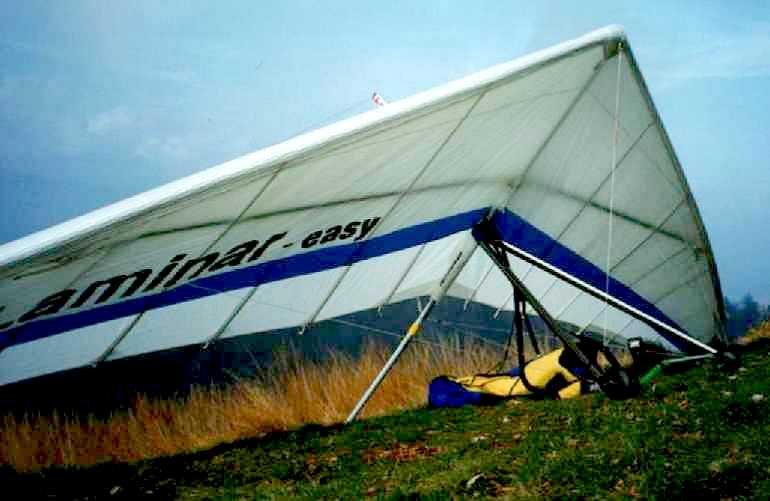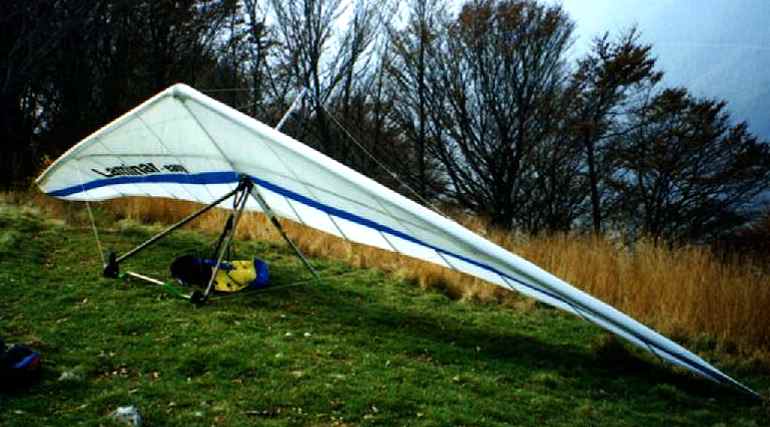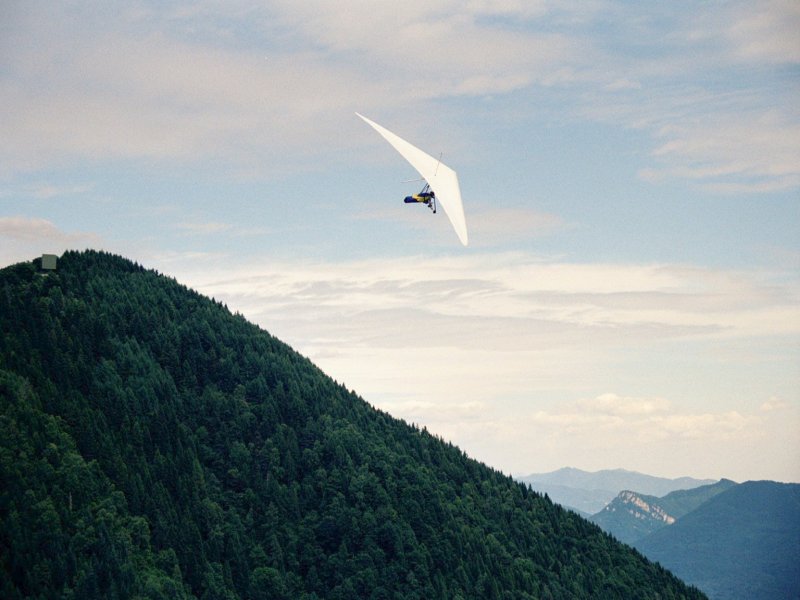Laminar Easy review, Feb 2000
What sort of pilot am I?
I've just restarted flying after a gap of ten years. Previously, I had around 120 flights (40 hours) spread over two seasons in the UK and a short trip to France. I had completed a few short (<30km) cross-country flights, and had flown mainly a Clubman 180 (i.e. a large one) and a Magic IV 166 (i.e. a medium one), as well as a few flights on various gliders such as a Comet, Atlas, Fhantom, etc. During training second time round I flew only the Icaro 2000 Mars (aka a Moyes Mars). I transitioned to a Laminar Easy 16 (i.e., a large one) in October 1999 after 16 high flights (800m top to bottom) on the Mars, and have now gathered another 20 on the Easy. Recently (Spring is starting here in Italy) I've got some real airtime in, with thermal flights including 400m altitude gain, etc. I've now got a reasonable amount of airtime to be able to consolidate an impression of what it's like to transition from a training glider onto the Easy. I'm 1.82m tall, and clip in at 88 to 90kg (198lbs).

Initial impressions
The glider when assembled and from the specifications is surprisingly "aggressive". I mean that it has an aspect ratio of slightly over 1:7, 74% double surface (the 14 is 80%!) and a nose angle of 127 degs. All this combine to give a sleek, slender impression, not dissimilar from your more normal competition gliders. The standard package includes most things you might usually consider as options on an intermediate glider: airfoil kingpost and uprights (rubber backed), mylar/matrix LE, speedbar, excellent heavy-duty bag, drop "stinger" keel for upright rigging. The hangpoint is a custom kingpost job with sewn in safety, looped round the keel. In general the build is excellent, with perhaps the sail being a bit lighter than I would have wanted - but then that cuts the weight down. There's virtually no keel pocket, the tip spars are carbon fibre with the standard Laminar curved tips... and it all looks very Laminar indeed. The give-aways are wider chord (looks like an extended trailing edge on a normal sail), fewer battens (8 top and 2 bottom each side, one nose), a slacker sail (particularly undersurface) and lack of VG. Oh, and the kingpost...
Nevertheless, the intention is that this is an intermediate glider. But don't get misled by the name, either.
Other specifications: the Easy 16 is a 15.7m2 (169 sq. ft), which for me gives a wing loading of around 7.8kg/m2 - high performance level, according to Dennis Pagen's manuals... I'm even a bit light for it, a deliberate choice in the low-wind conditions of typical flights in the Italian Alps. The Easy 16 is DHV 1-2 certified, the Easy 14 DHV 2 (link to DHV report).
Rigging
My glider in the bag, from the factory, weighed at least 33kg: the literature will tell you the glider weighs 30kg (I presume rigged) but since I fly with the bag and carry the whole damn thing around, the in-bag weight is more appropriate. In any case, it is lighter than a full Laminar R or ST. But it ain't no lightweight floater.
 The bag delivered with mine is a heavy water-resistant material, but is in fact quite prone to rips and holes. We'll see how it wears (I remember my Airwave bag having good resistance). Four good Velcro glider ties are included, but padding is minimal - just a short neoprene sleeve on the keel that needs to cover two bolts that otherwise scratch the uprights and a neoprene cap for the king post. The battens go in a good wrap bag with four compartments. The bag delivered with mine is a heavy water-resistant material, but is in fact quite prone to rips and holes. We'll see how it wears (I remember my Airwave bag having good resistance). Four good Velcro glider ties are included, but padding is minimal - just a short neoprene sleeve on the keel that needs to cover two bolts that otherwise scratch the uprights and a neoprene cap for the king post. The battens go in a good wrap bag with four compartments.
The manual says that you can rig it flat (English hill style) or on the A-frame. I've never done the former, but I've dropped it flat once in high winds and was unable to release the crossbar tension in this position. This seems to me a bit strange and I would check this out more thoroughly if you're going to assemble flat regularly. Apart from that, the manual is OK (mine was shared between all Laminar models) but could be better (no photos, for one thing).
The rigging is fairly straightforward, bar the tip spars. I've had lots of advice on this, but there is an "easy" way (took me 15 rigs to get it). First, assemble the speed bar (two pip-pins), flip the glider and arrange the king post and luff lines. Attach the cable from the kingpost to the keel, then spread the wings (still with protecting "socks" on them), and tension the crossbar fully (can be done with two fingers if assembled upright). Starting at the root, insert all but the last two or three upper battens; now you're ready for the tip spars (advice on how to do this). After a bit of practice this is all quite fast and doesn't require much grunting...
After this, stuff the remaining top and bottom battens, clip the nose, add the nose cone, and pre-flight.
Note: my Easy 16 has no dive rods... although the 14 does.
Ground handling and Take off
I've never had a TO problem I could put down to a handling fault. The glider is slightly tail-heavy, but easily allows you to get the nose down on a run. The side wires are relatively tense (cf. my old Magic IV or today's high performance gliders), although they are slacker than most training gliders. As such, balancing the glider is pretty straightforward. The glider is not lightweight, but carries easily (due to the good static balance). The A frame is long, though (and I'm 1.82m, 6' tall) - small pilots beware.
The airspeed required to take off is quite low, so a good run does it OK, even in nil wind. No big surprises.

Flying, and thermalling
First off, if you've only flown a 4th gen with a fixed cross-boom... take it easy on this glider. My first flight produced my first experience of real Pilot Induced Oscillations (PIO) - and I transitioned my first time round straight onto 5th gen. gliders and had flown Magic IV's. I remain convinced that this is not a direct problem with the Easy (despite 127 deg nose angle and a biggish span) but instead was a consequence of high altitude airtime on the Mars, which handles like a brick (full weight shift in anything but calm conditions). The PIO was already largely gone by the second flight, but it took me three (15 min) flights to start to coordinate turns and approaches really safely. After 15 flights I was still coming out of turns too fast and yawing; even now, accelerated flight can result in slight yawing, but this may also be due to my (light) wing loading.
Otherwise, the usual things you'd expect: light (easy, even) response, positive and gradual feedback from the bar, but good acceleration. I was impressed on my first flight at how smooth it was - no vibration, no wobbles (once I'd got the PIO sorted). Mine does great flat turns (I'm perhaps a little light for it); in thermals, it doesn't seem to need high siding, and in fact has a general slight tendency to come out of the turn, not a bad trait in an intermediate glider. Min sink is best achieved with the bar way out in the thermal, this takes quite a bit to get used to at first but the worst that has happened is a sliding spiral half turn that is resolved quickly with a pull and opposite shift. It goes up with the best of them, and as long as it's big enough to fly in, you'll climb as fast as most flex wings and paras.
On a glide, I've yet to really compare, but I don't expect it to be much different from the 1:10 or 1:11 L/D usually seen with gliders of this type.
My 16 hardly stalls if the bar is pushed out gradually - and even a sharper push results in a clean and sensible stall with good recovery.
Landing
This really is like the name says: So far, I've dropped a wing tip twice (first two flights). Since then I've found, if you follow the rules, that the Easy is predictable and stable. In 20 nil or low wind landings I've yet to put the bar on the ground, although sometimes I've run a bit (cross-wind). I prefer DBF approaches (especially good for earlier flights) since a few accelerated turns close to the ground can be disorienting and dangerous (at least one Easy crashed in this way at our club on a maiden flight). Despite warnings of converting speed into distance, etc., I've find that an upright stance on final can nicely disrupt efficiency and bring me down steeply: I go semi-prone if I find I'm coming down short. Once in ground effect, the glider goes on maybe 20-30m (nil wind) and then gives a huge opportunity to decide when to flare. A tentative gradual push followed by a short (30cm!) effortless push on the uprights (long uprights, so hands up) stops the glider so easily that I've been caught out to find myself standing there thinking: I've landed... I've never flown a glider so easy to land. Even the Mars was more effort. My British fear of nil wind landings has evaporated.
This said, the landing approach takes thought, as it does with any glider, and make sure you've plenty of room the first few times.
Overall conclusions
The Easy is no introduction 5th gen glider - it's a real intermediate. On a British hillside, doing your very first top landing on it must be daunting (mine, after 50 mins of airtime, on my Clubman was a doddle). This glider seems to give me the kind of performance I expected from my old Magic IV, with softer handling. Nevertheless, it allows you to concentrate quickly on the mental part of flying - looking for lift - and still be confident about manoeuvring in crowded skies and setting up your landing. It's somewhat lighter than the main Laminar series, but is no floater. Handling is stable enough for this glider to be - with care - your first 5th gen glider. But I'd recommend some airtime on at least a floating cross boom 4th gen first.
The finish on this glider is compatible with the price - which is nevertheless competitive with similarly spec'ed gliders. Parts seem to be reasonably priced too, and delivery for mine was a modest 5 weeks (at the factory).
Improvements? Better choice of standard sail colours (mine's white with a blue strip on the undersurface), maybe a VG option or retrofit? There's not much to add really, since it's mostly there anyhow. If you really want to get better performance... then you'd better go for an R or an ST. On this angle, a significant omission for me is wheels - should be standard on an intermediate glider.
Overall I'm happy. I've a glider that I think is safe for my level of flying skills and that is as good a performer as the one I flew ten years ago... It's got Laminar emblazoned on it and some nice features. I'm enjoying flying it, and that's what it's all about.
Article © 2000 Simon Kay, Besozzo, Northern Italy
Email: simon.kay@libero.it

|
© Copyright
2004
Flyblog.
Last update:
22/12/2004; 22:27:00.
This theme is based on the SoundWaves
(blue) Manila theme. |
|
|

